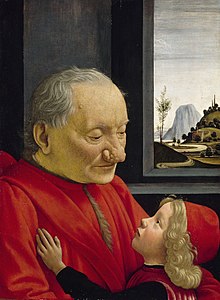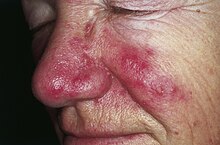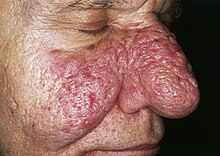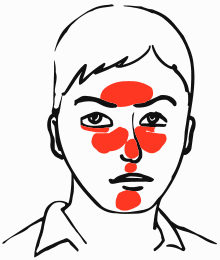Rosacea
| Classification according to ICD-10 | |
|---|---|
| L71.- | Rosacea |
| L71.0 | Perioral dermatitis |
| L71.1 | Rhinophyma |
| L71.8 | Other rosacea |
| L71.9 | Rosacea, unspecified |
| ICD-10 online (WHO version 2019) | |
Rosacea or rosacea ( ʁozaːt͡sea ) outdated term acne rosacea ( lat. For copper fins and copper fin rash or Rotfinnen , and copper rose and Kupferakne called - older even Gutta rosacea called), is a skin condition that mainly occurs in the region of the midface, mostly aged begins between the ages of 30 and 40 and often increases significantly between the ages of 40 and 50. They may have similarities to acneshow, but the underlying diseases are different. Rosacea manifests itself through patchy, sometimes scaly redness, but also swelling of the facial skin and inflammatory papules and pustules . Later, in men in particular, bulbous growths of the nose can develop, called rhinophyma ( Greek ῥίς, ῥινός "nose" and φῦμα "ulcer, growth") or bulbous nose, pound nose, cauliflower nose and potato nose .
trigger
The cause of rosacea is largely unclear, but various factors are believed to be involved. In addition to the regulatory disturbance of the vascular supply to the face, neurogenic inflammation, a disturbance of the immune system and the involvement of hair follicle mites and bacteria (e.g. Staphylococcus aureus ) are discussed . The neurogenic inflammation is a reaction of the central nervous system to stress. The disease rarely occurs before the age of 30, usually only after the age of 40. Women and men are equally affected (possibly with a slight overhang in women). Coffee , tea or alcohol , as well as hot spices and sunbathing, can worsen the condition.
Symptoms

Painting by Domenico Ghirlandaio (1488). (The lack of the typical reddening of the skin is explained with the creation of the painting only after the time of death.)
Severity I
Rosacea usually begins inconspicuously with reddening of the skin, especially in hot, cold and emotionally stressful situations. The fine, superficial blood vessels are significantly enlarged, and the skin looks reddened like sunburn. This first form of the disease is called couperose or erythematous - telangiectatic form. Small papules can occur. In addition, many patients complain of general skin irritation such as burning, stinging, itching, or dryness.
Severity II
In the second stage, the papulo pustular form of rosacea ( rosacea pustulosa ), pustules, nodules and swellings appear, which become inflamed, purulent and degenerate and can persist for weeks. The skin is swollen, red and large-pored. The course of the disease is phased and can drag on for years. The similarity to acne sometimes leads to misdiagnosis, but the acne-like purulent pustules and wheals in rosacea do not originate from the hair follicle .
Severity III
Men in particular suffer from glandular-hyperplastic rosacea. The proliferation of connective tissue and sebum glands create nodular thickenings: "lumps" or so-called phymas. The special form of the rhinophyma , the bulbous nose, is probably the best known form. If the eyes are also affected, one speaks of the ocular form or ophthalmic rosacea: Changes to the eyes such as conjunctivitis and eyelid margin inflammation , dryness of the eyes and, in the worst case, corneal inflammation .
therapy
Avoidance of the trigger factors (see above)
Rosacea skin is extremely sensitive to chemical and physical stimuli, so all irritating products containing soaps, alcohols, menthol, camphor, scrubs , etc. should be avoided as well as friction and exposure to the sun. Personal and individually varying triggers or " trigger " factors that lead to sudden reddening of the face or generally to vasodilation (such as alcohol, spicy foods, hot drinks, sauna visits, etc.) should also be avoided.
Cosmetic care
Appropriate care that soothes the skin and inhibits inflammation prevents irritation and redness. Daily treatment at home is based on cleansing the skin with mild agents. Avoid rubbing the face when drying. Good results are achieved with facial massages. The face is massaged in the morning and evening with light, circular movements with the help of a lubricant. Creams should be free from fragrances and preservatives and not too fatty. Preparations with thermal water and gel-based care products soothe and reduce the feeling of heat. For the day cream, UV protection makes sense, which is mandatory when staying in the sun (preferably SPF 50). The application of a light, suitable make-up or covering foundation (in a shade of green) does not worsen the rosacea, but has a positive influence on the patient's quality of life.
Medication
Topical therapy
External treatment is usually sufficient for the first two degrees of severity of rosacea. In Germany, nitroimidazole (0.75% metronidazole in different bases) and azelaic acid (15%) as well as ivermectin for rosacea treatment are approved for topical therapy . Antibiotics such as metronidazole, but also erythromycin , clindamycin and tetracycline have different levels of effectiveness, although the mechanism of action in these sub-therapeutic doses is not really clear. It is assumed that a “general anti-inflammatory active component” in metronidazole is effective for rosacea. Doctors see no risk of resistance developing in the case of subtherapeutic antibiotic treatments, since no selection pressure would be exerted, while an antibiotic underdosing promotes bacterial antibiotic resistance from a microbiological point of view or enriches (multi-) resistant germs (investigated primarily in animal fattening, so that subtherapeutic amounts of Antibiotics that were used as growth promoters are now banned across the EU).
The insecticide ivermectin is used orally or as an ointment to treat rosacea in Germany. Its effect is directed against hair follicle mites . The effectiveness is higher than placebo and a little higher than that of metronidazole. These mites live in the skin of practically everyone. However, it is still unclear whether they themselves or bacteria found in them play a disease-aggravating role at all.
Medications containing cortisone should not be used as they worsen symptoms.
Systemic therapy
The oral administration of antibiotics should be reserved for the severe forms of rosacea. Tetracyclines have been used successfully for treatment for decades , and newer derivatives such as doxycycline and minocycline are also effective. However, side effects (such as sensitivity to light, discoloration of the skin or mucous membranes) and contraindications (pregnancy) must be considered. Alternatively, macrolides (erythromycin, clarithromycin, azithromycin), metronidazole and other antibiotics are used. Antibiotics always have side effects - also on the important bacterial microflora - and should always be used in accordance with the current principles of rational antibiotic therapy. Another highly effective active ingredient is isotretinoin , a vitamin A acid derivative and natural insecticide that is effective against hair follicle mites but has many side effects. In particular, it can cause irritation of the skin, mucous membranes and conjunctiva, headaches and liver dysfunction, possibly also depression. In women, because of its embryotoxic effect , it may only be used if pregnancy is absolutely certain.
In August 2013 companies which received Dermatology Galderma by the US Food and Drug Administration FDA approval for a drug called brimonidine , an α2 adrenoceptor - agonist . Took place in December 2013. For the EU Committee for Medicinal Products for Human Use (CHMP) , the positive opinion , a kind of recommendation for approval. In February 2014, brimonidine - the first and only drug for the treatment of redness in rosacea - was also approved for the 28 countries of the EU.
Alternative forms of therapy
Initial laboratory tests showed that lidocaine could be a promising active ingredient if staphylococci are involved in rosacea, as it can specifically inhibit the inflammation triggered by the staphylococcal toxin. Products for external use, which contain the endolysin Staphefekt obtained from bacteriophages , are also specifically directed against Staphylococcus aureus . This enzyme specifically destroys the cell envelopes of S. aureus , causing the bacteria to burst. Furthermore, the use of healing earth in the form of face masks has proven to be effective. This has an antibacterial and anti-inflammatory effect.
Operative removal
The veins can be permanently removed by laser treatment , in which the enlarged blood vessels are closed and thus invisible. The rhinophyma (bulbous nose) can be removed by surgical removal, e.g. B. by grinding or with the CO 2 laser .
Eye care
Rosacea can spread to the eye and lead to permanent eye damage ( corneal clouding ). That is why regular ophthalmological checks are necessary.
reception
When Wilhelm Busch found in criticism of the heart a poem on the Rhinophyma:
Children, let us sing about it,
But without any envy,
Uncle Kasper's red nose,
Which has so often pleased us.
Once it was given to him as a tender plant
by nature;
He diligently watered you,
soaked you with wine and schnapps.
Soon he noticed with joy
that the young bud swelled
until it became a rose,
dark red and wonderful.
All roses have thorns,
this rose does not have them,
only has a tuft of hair,
which does not sting anyone.
Sweet
fragrances
emanate from her goblet , with all due respect: she draws her pollen
from the well-known can
.
Often on a fresh morning it
shows us a fragrant blue,
And on its heart
leaf a droplet of pearl dew flashes.
When the other flowers wither,
When it's rough and cold in winter,
Then this wonder rose has
the right shape.
So at her price and glory
let us sing this beautiful song.
Vivat Uncle Kasper's Nose That Blooms
at All Times!
literature
- S1 guideline for rosacea of the German Dermatological Society (DDG). In: AWMF online (as of March 1, 2013)
- HE Baldwin: Diagnosis and treatment of rosacea: state of the art. In: Journal of Drugs in Dermatology . Volume 11, Number 6, June 2012, pp. 725-730, ISSN 1545-9616 . PMID 22648219 . (Review).
- PM Lehmann: Rosacea: Epidemiology, Pathogenesis, Clinic and Therapy. In: Deutsches Ärzteblatt . 104 (24), 2007, pp. A-1741 / B-1536 / C-1475.
- Ingrid Moll (Ed.): Dermatology. (= Dual row ). 6., completely revised. and exp. Edition. Georg Thieme Verlag, 2005, ISBN 3-13-126686-4 .
- A. Müller, RW Schlecht, Alexander Früh, H. Still The way to health: A faithful and indispensable guide for the healthy and the sick. 2 volumes, (1901; 3rd edition 1906, 9th edition 1921) 31st to 44th edition. CA Weller, Berlin 1929 to 1931, Volume 2 (1929), pp. 217-219.
Web links
Individual evidence
- ↑ Jürgen Martin: The 'Ulmer Wundarznei'. Introduction - Text - Glossary on a monument to German specialist prose from the 15th century. Königshausen & Neumann, Würzburg 1991 (= Würzburg medical-historical research. Volume 52), ISBN 3-88479-801-4 (also medical dissertation Würzburg 1990), pp. 135 and 164.
- ↑ a b M. Sand, D. Sand, C. Thrandorf, V. Paech, P. Altmeyer, FG Bechara: Cutaneous lesions of the nose. In: Head & face medicine. Volume 6, 2010, p. 7, ISSN 1746-160X . doi: 10.1186 / 1746-160X-6-7 . PMID 20525327 . PMC 290354 (free full text). (Review).
- ↑ Volker Nölle: Rosacea - a guide . WiKu, Berlin 2003, ISBN 978-3-936749-83-0 , p. 27 ff .
- ↑ Simone Reisdorf: Rosaceather therapy: With doxycycline against inflammation . In: Deutsches Ärzteblatt . tape 106 , no. 43 . Deutscher Ärzte-Verlag , October 23, 2009, p. A-2159 / C-1810 .
- ↑ H. Schöfer: Topical therapy of rosacea . In: The dermatologist . tape 64 , no. 7 , 2013, p. 494-499 , doi : 10.1007 / s00105-012-2518-5 .
- ↑ ED Deeks: Ivermectin: A Review in Rosacea. In: American journal of clinical dermatology. Volume 16, number 5, October 2015, pp. 447–452, doi: 10.1007 / s40257-015-0150-8 . PMID 26254001 (Review).
- ↑ EJ van Zuuren, Z. Fedorowicz et al.: Treatments for rosacea. Cochrane Database of Systematic Reviews, April 28, 2015 doi: 10.1002 / 14651858.CD003262.pub5
- ^ David J Goldberg, Alexander Berlin: Acne and Rosacea: Epidemiology, Diagnosis and Treatment . CRC Press, 2011, ISBN 978-1-84076-616-5 , pp. 57 ( limited preview in Google Book search).
- ↑ Galderma: Galderma Press Release: Galderma Receives FDA Approval of Mirvaso . August 26, 2013, accessed March 4, 2014 .
- ↑ Mirvaso - Meeting highlights from the Committee for Medicinal Products for Human Use (CHMP) December 16-19, 2013 , from the website of the European Health Authority (EMA), accessed on March 4, 2014.
- ↑ Galderma: Galderma Press Release: Mirvaso® (Brimonidine) the first and only Treatment targeting the Facial Redness of Rosacea approved by the European Commission. February 26, 2014, accessed March 4, 2014 .
- ↑ Qingqing Jiao et al .: Lidocaine inhibits staphylococcal enterotoxin-stimulated activation of peripheral blood mononuclear cells from patients with atopic dermatitis. In: Archives of Dermatological Research . 305 (7), 2013, pp. 1-8.
- ↑ Products with staphefect are currently only available from Micreos Human Health and have not yet been approved for medicinal products.
- ↑ Otto Nöldecke (ed.): Wilhelm Busch. Complete Works. Volume 6, Munich 1943, p. 253.


